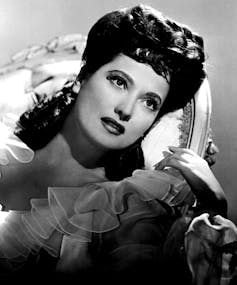Poetry, parties and ‘strong Australian tea’. The surprising story of how Anzac Day has been marked in the US for over 100 years
- Written by Yves Rees, Lecturer in History, La Trobe University

Since 1916, April 25 has been a de facto national day for Australia, commemorated as the occasion Australian and New Zealand troops began the ill-fated Gallipoli campaign in 1915. But for more than a century, Anzac Day has also been marked by Australians in the United States, via rituals[1] ranging from songs and bingo to dinners and football games.
In 1922, 100 Australians congregated for an Anzac Day dinner at New York’s Hotel Pennsylvania, then the largest hotel in the world. Although this dinner was held only four years into the peace and with war memories still fresh, it was far from a sombre affair.
The event was an exuberant gathering, continuing well after midnight. Guests recited poetry and performed songs, with a telegram from Prime Minister Billy Hughes read to the assembled crowd. “On this day, sacred to or nation, Australians, wherever they may be, are bound together by the crimson tie of kinship,” Hughes wrote.
Later in the 1920s, there were Anzac Day events in Honolulu, Los Angeles, Chicago and Boston. These were upbeat social gatherings, quite different to the funereal Anzac rituals that emerged later in the century. At the time, Australians were still British subjects (not Australian citizens) and travelled on British passports. At this early stage, Anzac Day was about empire as much as nation.
These interwar dinners and dances were sporadic, ad hoc gatherings, not official commemorations. Before 1940, there was no Australian embassy or consulate in the US to organise state events, and the Australian community was small and highly assimilated into the local population. It would take another world war for April 25 to become an annual fixture in the US.
Read more: Crowds at dawn services have plummeted in recent years. It's time to reinvent Anzac Day[2]
Clubs, dinners and a garden
The outbreak of the second world war in 1939 was accompanied by a dramatic upswing in Anzac activity in the US. That year, the Australian Society of New York was established to organise social events and fundraise for the war effort. The highlight of the society’s calendar was the annual Anzac Day dinner.
The 1942 dinner was a deluxe extravaganza organised by the Australian-born celebrity decorator Rose Cumming[3].
Held at the Waldorf Astoria, it was attended by 1,800 guests including British Ambassador Lord Halifax, Australian Minister for External Affairs H. V. Evatt and former US Presidential candidate Wendell L. Wilkie. British prime minister Winston Churchill and Australia’s John Curtin sent telegrams. The guest list included the rich and famous, with various Rockefellers, Vanderbilts and Rothschilds, alongside Hollywood star Merle Oberon.
This New York dinner, held two months after the fall of Singapore[4], was a high-stakes affair, which sought to strengthen the newfound Australian-US alliance. Essentially a public relations exercise promoting the idea of Australia to an audience of US elites, it was a roaring success.
The evening was sponsored by corporate heavyweights such as General Electric, General Motors and Chase National Bank. South-Pacific Supreme Commander Douglas MacArthur cabled an effusive message of support.
In these war years, Anzac activity was not limited to Anzac Day. The Australian Society organised Anzac cocktail parties and bingo nights year-round. It also established an Anzac War Relief Fund to raise money for Australasian servicemen. In 1941, a Pacific Coast branch of the fund was established by Australians in Hollywood, an occasion marked by a glamorous party at the Riviera Country Club.
Then there was the Anzac Club. The brainchild of New Zealand actress Nola Luxford[6], the club was a home-away-from-home for Australasian servicemen in New York. After the New York club opened in 1942, other Anzac Clubs opened in Detroit, Boston, Chicago and Washington DC.
These clubs became de facto Australian embassies and were renowned for serving “strong Australian tea” – a rare pleasure in a coffee-drinking nation.
During the war, New York also acquired an Anzac memorial garden, located atop the Rockefeller Center’s British Empire Building at 620 Fifth Avenue. The garden featured a central pool to represent the Pacific Ocean, bordered by three garden beds symbolising Australia, New Zealand and the US – a design anticipating the tripartite alliance formalised with the 1951 ANZUS treaty.
Since opening in 1942, the Anzac Garden has hosted annual Anzac commemorations. In 1943, First Lady Eleanor Roosevelt attended the garden’s re-dedication ceremony, a publicity coup boosting awareness of the venue and promoting the Anzac cause. To this day, the Anzac Garden remains the only permanent Australian monument in New York City.
Read more: Friday essay: do ‘the French’ care about Anzac?[7]
Anzac resurgence
As in Australia, the past few decades have seen a resurgence of Anzac commemoration in the US. As thanks for Australian participation in the “war on terror”, in 2005 the Bush administration introduced the E-3 visa program, which made special provision for Australians to live and work in the US. As a result, the Australian population of New York City alone quickly grew from 5,000 in 2005 to 20,000 by 2011. By 2019, there were almost 99,000 Australians resident in the US.
For this expanded Australian diaspora, Anzac Day remains an opportunity to gather. In New York, April 25 is marked by social gatherings, as well as church services and Anzac Garden ceremonies. The city also hosts a Dawn Service at the Vietnam Veterans Plaza.
The Australian Embassy in Washington DC organises a regular Anzac Day event, as do Australian consulates in Chicago, Los Angeles, San Diego and Houston. In 2019, San Francisco had no fewer than four scheduled events, including a coffee meet-up, a sausage sizzle, a football game and a formal service.
Unlike the upbeat gatherings of the 1920s, these contemporary Anzac events tend to be sombre and moving, with tears often shed. Just as in Australia, Anzac Day in the US is becoming more emotional, rather than less, as the two world wars recede from living memory.
Throughout the US, special Australian rules football games are played on April 25, mirroring the Anzac Day clash between Collingwood and Essendon, which began in 1995.
In San Francisco, the Golden Gate football league plays an annual Anzac Day round, followed by an Australian lunch of meat pies and beer. Other Anzac gatherings serve iconic Australian foods like Tim Tams, lamingtons, meat pies, sausage rolls and – of course – Anzac biscuits.
These days good coffee rather than tea has become a marker of Australianness abroad. In the 2010s, Manhattan’s Australian-run Bluestone Lane café began serving free flat whites and Anzac biscuits to attendees from the nearby Dawn Service. The café’s San Francisco outlet also offered complimentary coffees.
Memorial diplomacy
April 25 has also become an occasion to reaffirm the Australian–US alliance. In recent years, Anzac services have been attended by high-ranking officials from both countries, who have used the occasion to emphasise trans-Pacific cooperation and friendship.
In 2021, US Secretary of State Antony Blinken noted that the “kinship our armed forces share” dates back to 1915. In 2022, former prime minister Malcolm Turnbull addressed New York’s Dawn Service, while former governor-general Quentin Bryce gave the Anzac Day address at New York’s Trinity Wall Street Church. Both speeches relayed the history of Australian-US wartime cooperation and stressed – in Bryce’s words – that “today is a day for all of us”. In 2024, Bryce will once again give the Anzac Day address.
This trend is an example of what historian Matthew Graves calls “memorial diplomacy[8]” – the use of commemorative events to create or reassert geopolitical alliances. As the ANZUS treaty enters its eighth decade, Anzac Day in the US has been repurposed as a celebration of that strategic relationship.
In many respects, Anzac remains as much about empire as nation – only these days the British empire has been usurped by the American.
References
- ^ rituals (www.tandfonline.com)
- ^ Crowds at dawn services have plummeted in recent years. It's time to reinvent Anzac Day (theconversation.com)
- ^ Rose Cumming (www.rizzoliusa.com)
- ^ fall of Singapore (www.nma.gov.au)
- ^ State Library of Victoria (handle.slv.vic.gov.au)
- ^ Nola Luxford (teara.govt.nz)
- ^ Friday essay: do ‘the French’ care about Anzac? (theconversation.com)
- ^ memorial diplomacy (ebookcentral-proquest-com.ez.library.latrobe.edu.au)





